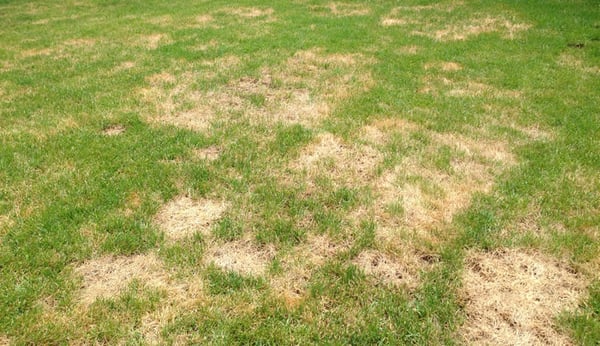As your yard is starting to green up and grow, you may notice some unusual patches in your grass that don’t look as healthy, or may not even be growing. Even worse, you could notice that weeds have overtaken the grass. May is the month that weeds, especially dandelions, rear their ugly heads and insects such as leatherjackets and grubs feast on the grass and its roots as they mature into adults. Over-seeding is the best way to fix these problems in your lawn.

Insect Damage
Now is the time to look for insect damage since they’re often not discovered until the damage has been done.
Grubs from insects such as June and Japanese beetles and European chafers look like little white c-shaped worms with a brown head. They damage your grass because they feed on the grass roots, and digging tunnels in the soil, killing the grass and leaving the ground spongy. Also, skunks and racoons find grubs quite tasty and will often dig up your yard in search of a snack.
Leatherjackets are the larvae of the European crane fly, are greyish in colour and can be up to 3 cm in length. They feast on the grass blades and will even eat it down to the roots. If you have a large infestation, you’ll notice the most damage from mid-May to June.
Weeds
Unhealthy lawns breed weeds. If the grass is thin, weeds will take advantage and sprout, eventually overtaking the grass. Over-seeding helps to promote a thicker grass cover, eventually choking out the weeds, provided you have the proper lawn care regimen.
How to Over-seed Your Lawn
In order to combat bald or brown patches, or thicken up your existing grass, over-seeding is a must. Look for a seed that has a combination of fine fescue (light green & tolerates shade), Kentucky bluegrass (makes your grass lush and dark green), and perennial ryegrass (hearty against disease and sprouts quickly).
1) Mow your grass slightly lower than normal
2) Rake up the area a bit to break down any thatch
3) Top-Dress – add a thin layer of peat, topsoil or compost, which helps to hold moisture and adds healthy nutrients
4) Seed – add about a pound of seed per 200 square feet, or double the amount if you were seeding a new space.
5) Water – the seed must be kept wet until it germinates and starts to sprout (about 5-7 days), so start an hour after you’ve seeded and frequently, even multiple times a day if it’s hot to ensure it doesn’t dry out. After a week, reduce watering to twice a day, until the lawn is more established. Watch, though, that you don’t water so heavily immediately after seeding that the water runs off, taking the seed with it.
After over-seeding, make sure you have a good lawn care plan, including mowing, fertilizing and regular watering, to ensure your lawn stays healthy and green.
To contact your local Ottawa Nutri-lawn services including fertilizer service please click HERE or click on the link below to request a FREE quote.






